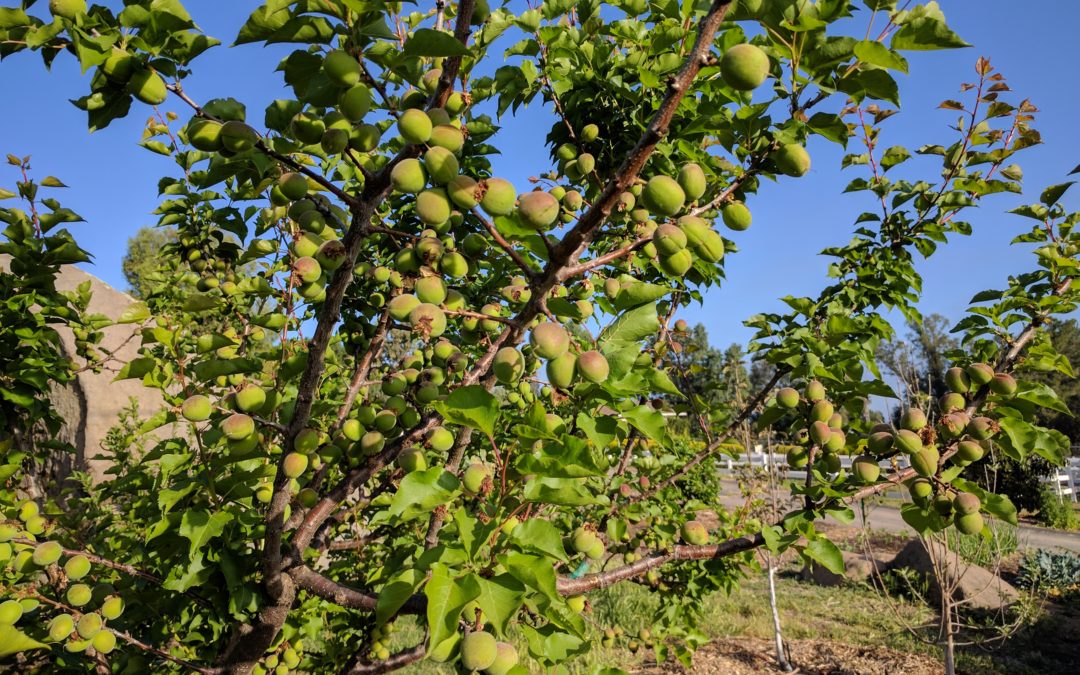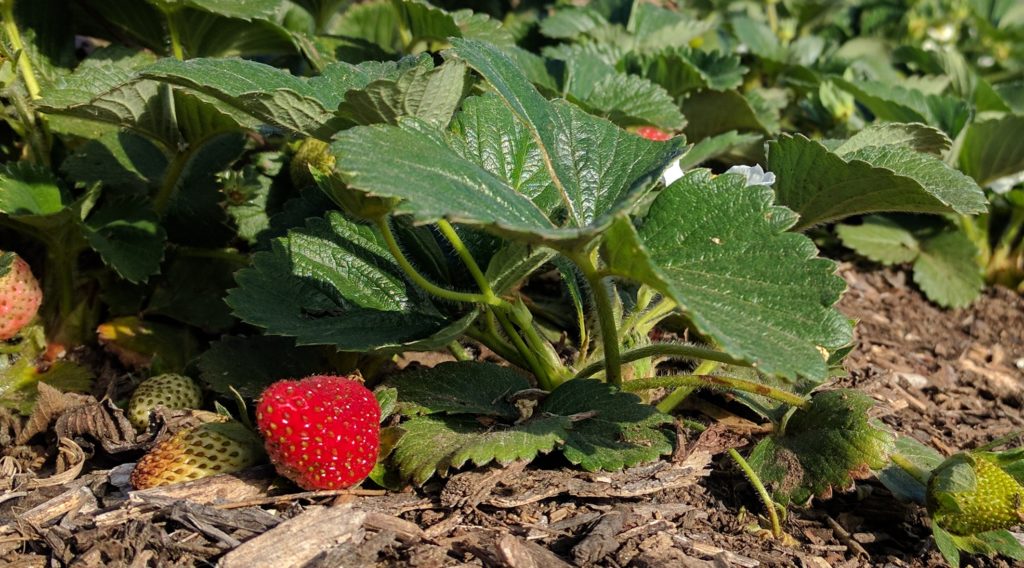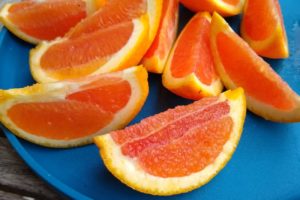In April, my gardening mind is busy, as I suspect is yours. Mostly, I think about three topics. The first is fruit set — flowers becoming fruit on the trees. The above photo is the fruit set on my Blenheim apricot today; this tree is an over-achiever, year after year.
And then I start thinking about irrigation this month too. It’s likely that we won’t get another real rain. Up ahead is about seven months of sunny and warm. I’ve always thought of growing food in Southern California as “just add water” because we have all of the sun we could want and none of the nasty weather (hail, high winds, flooding) that other places have in the summer. We just don’t get water from the sky during this time of year, so adding that is up to us.
April isn’t the month when a lot of watering is required, of course. But being the beginning of the irrigation season, it is the best, most forgiving time to fiddle with systems and dig down to test percolation and figure out schedules. On the other hand, doing this right before you’re about to leave on vacation in the summer would be the worst, least forgiving time. I think of time spent preparing irrigation now as doing my future self a favor.
And April begins open season on planting vegetables that like to grow through summer. It’s so exciting to now be able to freely sow and plant peppers, tomatoes, melons, eggplant and, well . . . here are the details on what we can sow, as well as other timely tasks out in your food garden in Southern California in April:
– Sow or plant vegetables: beets, carrots, basil, greens, tomatoes, tomatillos, sunflowers, squash, corn, beans, peppers, eggplant, cucumber, melons
– Eat vegetables (had you planted them): peas, broccoli, cauliflower, cabbage, brussels sprouts, greens, carrots, beets, lettuce, parsley, cilantro, spinach
– Eat fruit (if you have the trees): avocados (Hass, Fuerte, Pinkerton); citrus (Valencia, Gold Nugget mandarin, Pixie mandarin)
– Eat, eat, eat strawberries, and freeze, freeze, freeze the ones you don’t
– Prune deciduous fruit trees with only a twist of your fingers; if you made a heading cut in the winter and new shoots are sprouting below it now, just remove any of those shoots that you don’t want by snapping them off with your hand — it’s really that easy
– Get excited about fruit set on deciduous fruit trees and, should you be so lucky, consider thinning some fruit; if a skinny branch has a lot of fruit toward its tip then it’s wise to remove some fruit there so the branch doesn’t break under the fruit’s weight (peaches or nectarines) or get sunburned as the branch bends down (apricots, plums, apples); that being said, don’t bother thinning much more than that
– Get up close and enjoy the smell of the citrus blossoms on the trees in your yard
– Cut off the water to garlic and onions that you planted last fall as they bulb out toward the end of the month; they can finish their lives on residual soil moisture, and they’ll be dry and easy to harvest when their leaves yellow and die sometime in May
– Get gophers before they get your plants; there are a lot of young ones under the ground this time of year, and the best way I’ve found to keep them under control is the Cinch Trap
– Set up new irrigation on plants, test run all irrigation lines to check for clogs and leaks, flush drip irrigation lines, clean out filters — get that irrigation dialed in
You might also like to read:






I’m curious about your success with Blenheim. A trusted nursery told me our LA winters don’t have enough chilling hours, yet I see it in other nurseries. I love the fruit, but don’t have enough space to risk planting a tree that won’t produce. I see yours is productive in San Diego county. How many chilling hours do you get? By the way, thank you for this website. It’s terrific.
Hi Joe,
Thanks for the kind words and the excellent questions. I’ve been working on a post about apricots for a couple years now; you’ve reminded me that it’s high time to get it finished and onto the website.
About the Blenheim specifically, I’ve been reading here and there for the past ten years that apricots in general, and Blenheim especially, no longer bear consistently in the L.A. area because of warmer winters (due to whatever). My observations pretty much support that.
However, as for my Blenheim, it is the most productive and consistently bearing stone fruit tree in my whole yard. Even last year when our chill hours were relatively low, it still bore a full crop.
But I live in a semi-rural part of San Diego County called Ramona. My elevation is 1,450 feet and I get more chill hours than almost all of the urban parts of Southern California, judging by the cold damage done to my banana plants and the like compared to those in other yards. As for how many chill hours I get, it’s impossible to say with much accuracy since the nearest tracking station is in the San Pasqual Valley near Escondido, which is never quite as cold on winter nights as my yard. But I will note that I’m considered Sunset Zone 20.
Comparing Blenheim to other apricot varieties, let me also mention that I have a Goldkist branch grafted onto my Blenheim tree and the Blenheim branches far outproduce the Goldkist, which is inconsistent. It is also not a good producer at my mom’s house in Glendora, L.A. County, and a farm advisor here in San Diego County told me that he did a trial of apricot varieties some years back and also found that Goldkist did not bear well.
Others in San Diego County have reported to me that both Goldkist and Katy have not produced well for them.
I don’t have as much experience observing apricot varieties around here as I’d like. That being said, so far, the only apricot variety that I would consider recommending for most locations in Southern California is Tropic Gold. It has produced well in one yard in the San Diego area that I know has little winter chill. Here’s a link to the history of Tropic Gold apricot, and since L.E. Cooke no longer grows fruit trees, Dave Wilson has started growing these for sale at retail nurseries.
Just planted my first tomato of 2023! More going into the ground over the weekend.
Hello, just curious if you have posts on growing cherimoya trees? We live in the central coast with cool nights, morning fog, and typically only a few really hot days in the summer. We planted cherimoya trees in pots about 6 mos ago and at first they did great, but now they appear to be struggling. Leaves quickly turn brown and drop, we think its over-watering and have repotted and re-soiled them in hopes they dry out. Anyway, curious if you have experience growing cherimoya’s, or have any in the ground? Thank you.
Hi Laura,
I don’t have a post about growing cherimoyas yet.
The first, most important thing to know about growing cherimoyas is that they naturally lose their leaves every spring. About now, when other trees are growing new leaves, cherimoyas are losing their leaves. It’s disorienting. If you don’t know that they do this, you can think your cherimoya tree is dying. Don’t worry: soon they will grow new leaves.
Hi Greg, thank you for the reply and info.
In looking at fertilizer recommendations, I’ve read 8-8-8 and 10-10-10 is recommended for cherimoyas. Trying to avoid buying yet another fertilizer, do you think Dr. Earth 4-6-5 fertilizer would be good on the trees? (they are actually about a year old and 6-10 inches tall, and were planted from seed). Thank you.
What variety of tomato plants does well around Aguanga? Where can I buy some healthy plants?
In AZ we had a variety called Phoenix that was bred to do well in the heat but I do not find them here.
Just want to share that your blog changed our life. We have tried to garden here but it is all so different from our past. We have a very small space, so we felt embarrassed to show you how neglected it was. But your blog encouraged us, we have all new dirt and energy.
And,.. smile….we two head of lettuce volunteers from the year before last when nothing grew!
Please keep sharing your good work. May it prosper and add joy and beauty to your family.